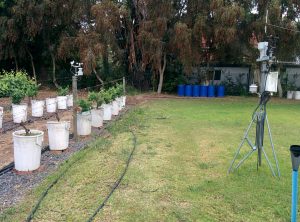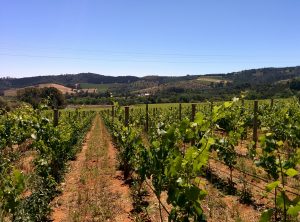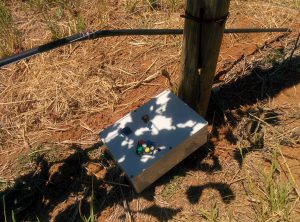AgriNet pursues 3 main objectives :
- Objective 1 : development of the communication stack
- Objective 2: machine learning and pattern recognition
- Objective 3: integration and pilot deployment
During this year, we have achieved significant advances regarding Objectives 1 and 2. Only small progress has been made regarding Objective 3 since it requires final results of the previous objectives. First experimentation have been conducted only to validate setting and technical choices for Objective 1 (See figure 6).
Progress regarding Objective 1:
Advances with regards to Objective 1 concern 1) hardware specification, 2) PHY selection and 3) MAC layer design.
Hardware and PHY layer
Each sensor node embeds :
- a microprocessor that hosts the communication stack,
- a wireless communication card to transmit data,
- different sets of sensors (temperature, humidity, etc,
- a power source and
- a module to allows external accesses for reconfiguration or requests.
Regarding the hardware and PHY layer, we have selected LoRa, NB 433MHz based sensor, that seems to present a good choice as WSN platform thanks to its robustness and long range features.
In order to validate these solutions, we have conducted several in-field measures.
- a)TX b)RX
The goal was to estimate the signal absorption by the ground as a function of the technology and the height at which the sensors are set. First measures aimed to determine the best adequate frequencies between 169MHz vs 433MHz. To do so, we measured the difference in signal strength received with both frequencies. We found that: as height of antenna increases, the difference in received signal strength decreases. Therefore we chose the 433MHz that offers similar range with much smaller antenna and higher throughput.
Then, we compared the characteristic of different technologies that made us choose the LoRa technology.
We are now investigating the use of multi-technology device. The goal is not to be one-technology
dependent and adapt dynamically according to the data QoS requirements. In this purpose, we have
proposed a smart dynamic Network Interface Selection (NIS) protocol that can fit constrained devices.
The NIS relies on a light adapted TOPSIS technique and has been shown by experimentation to
outperforms current solutions. Publications are under preparation.
MAC layer
Based on the choice of LoRA technology, we defined the requirements of our communication protocol that has to run over it and more specifically for the MAC layer.
The LoRa technology already comes with a MAC layer called LoRaMAC. LoRaMAC is a simple sender initiated ALOHA-based MAC protocol. The advantage of this solution is that it does not require development of any Radio Duty Cycle (RDC) strategy: the nodes can start their transmissions at any moment. Since, the sink node (the Base station) is always on and listening to all the available channels, the message could be received immediately, without any connection establishment process. However, this approach requires the full coverage of the target zone, which, is not always possible in our case.
Therefore, we rely on benefits of the LORA technology (such as the capture effect and efficient spread factor) to design a novel adaptive multichannel multihop MAC layer protocol.
Our protocol relies on a gradient that assigns a rank to each node depending on their distance in number of hops to the gateway. We divide the time in a superframe itself divided in timeslots. Each node chooses a timeslot within the superframe randomly and proceed to a competition to reserve it (in case several nodes wish to access the same timeslot. Once the slot is reserved, the node rank allows each node to know in what part of the timeslot and on what channel to communicate.
Each part of this algorithm has been implemented and evaluated on real platforms. First results have been published [Toldov18], while a Masters thesis will be submitted early in 2020 on the topic. (M. O’Kennedy).
Progress regarding Objective 2:
From Objective 2, we have made advances on two complementary aspects : decision making tools and data reduction. Advances achieved this last year are about this second aspect. They consist in the design of a Bayesian approach at the node level to reduce the quantity of data to send, and thus alleviate the network energy consumption.
Our Bayesian Inference Approach (BIA) allows avoiding the transmission of high spatio-temporal correlated data. Actually, we established there is a high correlation between different sets of data like for instance temperature and humidity. We set the way to recover one value from the other, which allows the nodes to send only one of them. Each node runs the Bayesian based prediction algorithm and send both values if and only if the predicted value is too different from the real data.
The gateway runs the same algorithm and thus can recover the whole set of data.
We have validated our model using real data issued from the PEACH project, which aims to predict frost events in peach orchards by means of dense monitoring using low-power wireless mesh networking technology. Belief Propagation algorithm has been chosen for performing an approximate inference on our model in order to reconstruct the missing sensing data. According to different scenarios, BIA is evaluated based on the data collected from real sensors deployed on the peach orchard. The results show that our proposed approach reduces drastically the number of transmitted data and the energy consumption, while maintaining an acceptable level of data prediction accuracy.
Progress regarding Objective 3:
Integration
Then is the integration of the final system (wireless sensor network and machine learning based system)
in a complete agriculture-oriented prototype. Pilot projects were expected to be deployed during the last
year in both France and South Africa focusing on two main cultures: potato crops and vineyards in order
to stress and evaluate the AgriNet prototype. Unfortunately, we could not achieve this large deployment
objective. We could only perform some tests in test vineyard to in situ validate our first outcomes as shown in the figures below.
The solutions are coupled with drones in order to generate humidity and thermal maps of the area. Robots are also used to conduct hard labor tasks (weeds removal, grape size color monitoring, etc).
The objective is to deploy a fully self-configurable multi-hop solution to monitor vineyards. Tests were conducted at Rustenberg wines vineyard.
Using two LoRa nodes: one as emitting source and the other one as a base station, they ran their experiments.
















